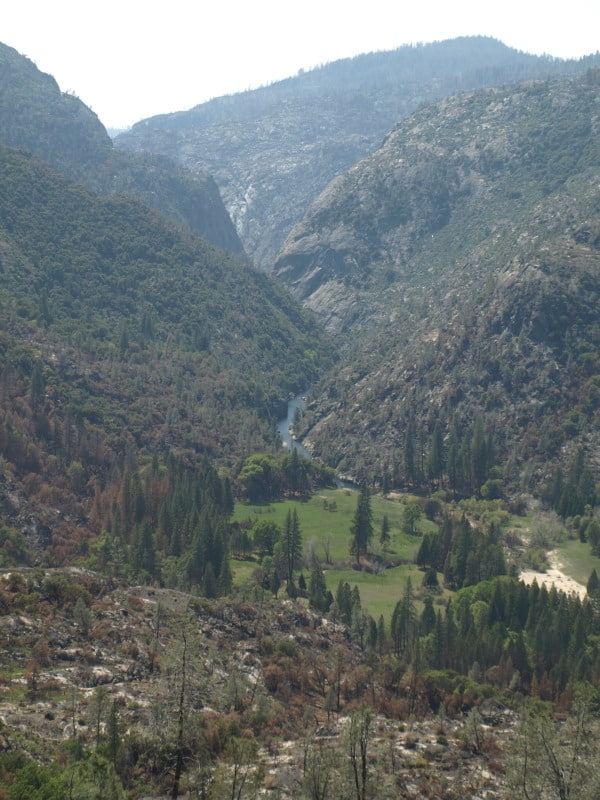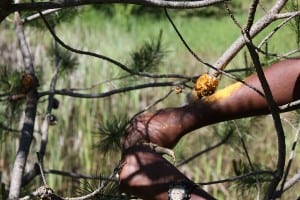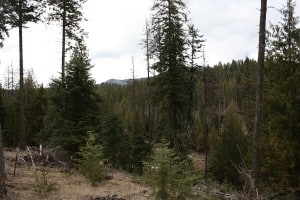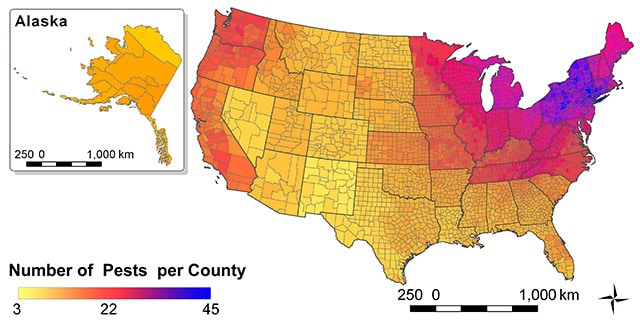All of you. June 6, 1944
Rim Fire Terrain Effects
Below is a picture of the Tuolumne River and Poopenaut Valley, just a mile or so below Hetch Hetchy’s O’Shaughnessy Dam. As you can see, the area burned rather lightly. What might be the reason for this area to survive, almost unscathed? I think there is a “micro-climate” at play, here. Most of this is Yosemite National Park.
Certainly, there are plenty of fuels, and California is in a historic drought. Firefighters did not “heroically” save this area from the flames. No management was done to make this area more resilient. Comparing this area to scorched places downstream, I think I have the answer. Farther downstream, the fires were enhanced by the nearly constant breeze, flowing down during the night and morning, and flowing up, with the heat of the day. Cold air sinks and warm air rises. This spot is pretty unique along the Tuolumne River. As the canyon turns from a glacier-sculpted valley into a V-shaped gorge, the cold air from higher elevations runs into this bottleneck, pooling up in this last valley, going downstream. Temperature inversions stay longer and stabilize the breezes, reducing fire behaviors.
One thing I did notice in this area was that many single digger pines were “selectively burned” as individuals. Those long slender needles were good at catching the small embers.
Anatomy of a Timber Sale Appeal Redux
Assiduous readers will recall the Bighorn National Forest’s Crater Ridge timber sale. Located high in Wyoming’s Rockies, Crater Ridge is a 400-year-old Engelmann spruce/subalpine forest that the Forest Service poked some holes into 25 years ago. Those holes remain today, complete with untreated slash piles and bare ground (click “satellite” in upper-right corner for pretty view).
When the Forest Service proposed last year to reprise its Crater Ridge silvicultural misadventures, FSEEE appealed and the Forest Service withdrew the sale.
The Forest Service, however, is not so easily dissuaded. It has re-proposed “similar” Crater Ridge logging. The only difference between the 2013 and 2014 versions are the addition of “reforestation actions such as fill-in planting.”
You can read FSEEE’s thoughts on this latest iteration. In a nutshell, the Bighorn forest plan doesn’t allow for “in-fill planting,” except to meet non-timber objectives. Worth noting also that the Bighorn promised it would plant the 1985 Crater Ridge units if nature failed to do so. Nature failed and so did the FS — it never planted a single seedling.
So what’s the Bighorn up to? Did it not get the memo that we don’t do things this way anymore?
Settlement agreements in litigation
Here is a textbook example, from the Stanislaus National Forest travel planning process.
- The Forest Service makes a decision
- Plaintiffs sue
- Intervention granted to supporters of the decision
- Court finds Forest Service violated a procedural analysis requirement
- Plaintiffs, intervenors and Forest Service agree on an interim solution while the process is redone
It looks like win/win/win/win:
- Plaintiffs: “Now we have 40 miles of the worst routes officially closed.”
- Intervenors: “At the end of the day, we need to be partners in effective forward-looking management and allowing this agreement to be approved as opposed to tilting at windmills.”
- Forest Service: “Diverse riding and driving opportunities for motorized recreation and dispersed camping still abound on the forest with over 230 miles of OHV trails available.”
- General public: Gets another chance to participate in the process
(Of course the goal in most litigation is to settle a case before a judge has to decide it.)
Springtime, and a young man’s thoughts turn to…
…rust spores, of course. Endocronartium harknessii. Here’s my new grad student (from Haiti) out learning a little forest pathology, and collecting some samples for my course next fall. Western gall rust, scourge of the lodgepole pine (and sometimes ponderosa). The urediniospores are out now and flying around by the billions, these are some small scruffy trees on a few acres just bought in north-central Idaho, they’re loaded with galls. 
Good thing these fungi are host-specific! (at least they don’t infect people) This week we’ll go out after WPBR, there are a few white pines on the property, previous owner planted supposedly “resistant” stock after more or less highgrading all the timber. I know a few local spots with white pine in sufficient numbers to find some rust, hard to believe that the former “King Pine” (=wwp) is the state tree of Idaho, many Idahoans have never even seen one.
Burn Intensity in the Rim Fire
I ventured into the Rim Fire, where access is (still) very limited, and found a variety of conditions. Along Evergreen Road, on the way into the Hetch Hetchy area of Yosemite National Park, I first saw an area that had a prescribed burn accomplished, a few years ago. A “windshield survey” of that saw that there were plenty of trees surviving. I wasn’t surprised to see scattered mortality. It remains to be seen how many of these green trees already have bark beetles in them. In fact, I’m sure that some trees have changed color since I was there, in late April.
Farther up the road, near the historic Camp Mather, I saw this managed area and wondered why it didn’t survive very well. You can see that understory trees were cut, reducing the ladder fuels. Farther up the gentle slope there appears to be some survivors. All of the trees in this picture are likely candidates for bark beetles, and the green ones can support more than one generation. We are already seeing accelerated bark beetle mortality outside of the fire’s perimeter.
I scanned around, looking for a reason why the stand had so much mortality. Looking across the road, down the hill, I saw the reason why. It is pretty clear that this stand hadn’t seen any management, and the hot wind from the fire pushed the crown fire across the road. Some of those trees were simply just “cooked” by the hot gases, blowing through their crowns. While I have seen these fire-resilient pines sprout some buds the next spring, few of them survive through the next summer, for multiple reasons.
With over 250,000 acres burned, of course there will be a varied mosaic, with lots of examples of things we like to talk about, no matter what your point of view is. I will post more examples of what I saw in future posts.
USFS National Advisory Committee meeting in Missoula
“Committee in Missoula helps Forest Service make plans for public lands,” The Missoulian today.
To explain how to get inside the U.S. Forest Service’s planning process, the agency has turned to a roomful of outsiders.
“This is participatory democracy at its finest,” said Ray Vaughan, a co-chairman of the Forest Service’s National Advisory Committee meeting in Missoula this week. “In the old style, the Forest Service figured out what it wanted to do and then asked everybody to comment. If you didn’t know about the comment period, you missed out. Now it’s more of an ongoing, organic, adaptive-management kind of process.”
List of committee members is here.
The committee is writing a “citizen’s guide” that explains the National Forest planning process.
Fading Forests III, America’s Forests: What Choice Will We Make?
And now for something completely different. I received a note from Faith Campbell about thes report, issued May 23.
Here’s a link and below is a summary:
Fading Forests III is a new report released by the University of Tennessee and The Nature Conservancy compiling the latest data and analysis on the introduction, spread, and costs of non-native invasive tree pests and diseases. Fading Forests III is the third invasive species study produced by co-authors Scott Schlarbaum of the University of Tennessee and Faith Campbell of The Nature Conservancy over a 20 year period.
Among the key findings:
In the last dozen years the emerald ash borer has spread from three states to 22; the Asian longhorned beetle has been detected at four additional sites; 28 new tree-killing pest species have been discovered.
Existing government programs have failed to halt introductions or respond effectively.
New pests are attacking tree species that have already been decimated by previous invasive species.
Spending to control and prevent invasive species lags far behind the growth of infestations and the value of the private and public resources at risk.
The site above links to the very cool Forest Service Northern Station Alien Pest Exchange, so if you click on the real map (not on the one I reposted) you can go to your own and neighboring counties and see what pests are there.
Thank you Nature Conservancy and Forest Service, and Scott Schlarbaum and Faith Campbell!
What Actions Should Be Taken To Counter Global Warming and What Are The Consequences?
We have just had a warm dispute about Global Warming. We discussed whether or not mankind has lived through much worse global warming than the present, contradictions in data and interpretation of the data as well as the validity of man made global warming and projections of the same.
Many feel that we have sufficient science to dictate that there is a very strong urgency to do something right now and others think that there are too many contradictions and differences of opinion to leap before we have more science because of the unintended consequences of acting on bad data. So let’s leave further discussion of what is the truth and what isn’t to the post linked to in the first sentence of this post.
LET US NOW ASSUME THAT GLOBAL WARMING IS AN INCONTESTABLE SCIENTIFIC FACT AND THAT THERE IS NO QUESTION THAT IT IS DIRECTLY RELATED TO EMISSIONS OF CO2 AND OTHER GREENHOUSE GASSES. Let us assume that global temperatures will warm 4.8 degrees centigrade over the present with no action per the Copenhagen Accord. That is significantly higher than the previous high temperatures over the last 11,000 years in the Samarian and Iron ages. Let us also assume that the change will occur over a shorter time period due to the modern man made influences causing the change to be complete by 2100 as stated in the Copenhagen Accord.
LET US CONSIDER THE ACTIONS NECESSARY TO KEEP GLOBAL TEMPERATURES FROM CLIMBING ANY MORE THAN 2.0 degrees centigrade per the target in the Copenhagen Accord. LET US CONSIDER THE CONSEQUENCES OF THOSE ACTIONS.
Let’s consider things like:
Do we move people into large cities and revert to bicycles? Does that increase the spread of infectious diseases?
Are we going to permanently clear National Forest ridges on the Pacific coast and load those ridges up with wind farms to increase our sourcing from wind farms to a significant level from the current 4% supplied to the grid. There are already groups complaining about their placement in the desert and their impact on endangered species. What are the consequences?
Are we going to excavate large newly found rare mineral deposits in Minnesota (or wherever they are) that many are already lining up to oppose in order to make the large solar farms and battery storage necessary to produce more than the 0.2% percent that solar panels currently supply to the grid. Or are we going to continue to rely on China for those rare earth minerals. What are the consequences?
What industries do we cut out? What are the consequences? What do we do with those who won’t have a job?
How long can we print money before the world devalues our currency? There is plenty of talk about that already and when interest rates go up we will end up with our whole budget going to repay debt or devalue our own currency. Actions are already being taken to cut Social Security and Medicare. How are we going to add more people to the dole? Who is going to subsidize the scaling up of this new technology and remove all of the environmental impacts?
Do we really expect the 110 countries to keep these commitments made on the basis of a wing and a prayer? Are the commitments glibly made by politicians who want to look good. Is it kind of like “We’ll have to pass it to find out what’s in it”? If we don’t impose and control this on a global scale will our US improvements make any significant difference?
Are we going to control the exponential growth in population in order to avoid the exponential increase in co2 emissions. Talk about consequences – think death panels and Obama Care. Are we going to put a cap on how old people can be to get medicine or surgery? Some expectations are that population growth will slow but we have already gone from 2 billion to 7 billion in my 68 years on earth.
Methane Gas is the second most prevalent green house gas. Are we going to triple the price of milk by requiring that all bovines be equipped with leak proof methane gas capturing devices?
Please add to the list. Talk is cheap so we all can chip in. 🙂 I plead ignorance. I only have questions. Shouldn’t we be asking these questions?
Finally, who will have the say as to what is done and how it is done. Won’t any such efforts be even more controversial and ineffective than our current policies regarding the managing our national forests? If we can’t agree on the long term consequences of current forest and endangered species policies, how are we going to agree on policies to limit global warming and the consequences? Will legal and analysis paralysis combined with everyone demanding their way or the highway only hamstring good intentions by trying to manage by an all inclusive committee? Lives will be much more impacted by global warming control measures than they are by forest policy. Will we see all of the states break off from the nation to protect the interest of their people? Uncle Sam won’t be able to do anything to stop it – no war, no nothing just everyone withdrawing in mass. Will D.C. muster an army to keep all of the other states in line?
Do we really know enough to make all of these decisions ASAP as some insist we must? Let’s classify the proposed actions as to 1) Quick and Easy, 2) Obama Care Tough and 3) Dismembering the Union.
Does George Carlin ring true on anything? At least it is a sad laugh.
Planning FACA Committee Meeting in Missoula
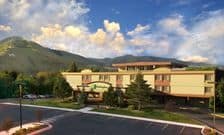
Next week is a meeting of the Planning Rule FACA committee in Missoula which will be webcast also. Here’s a link.
Hopefully some of you will attend in person or via webcast, and share your thoughts on the blog. Please consider this an invitation…

